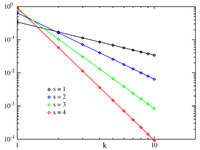
Photo from wikipedia
Studies of risk perceived using continuous scales of [0,100] were recently introduced in psychometrics, which can be transformed to the unit interval, but the presence of zeros or ones are… Click to show full abstract
Studies of risk perceived using continuous scales of [0,100] were recently introduced in psychometrics, which can be transformed to the unit interval, but the presence of zeros or ones are commonly observed. Motivated by this, we introduce a full inferential set of tools that allows for augmented and limited data modeling. We considered parameter estimation, residual analysis, influence diagnostic and model selection for zero-and/or-one augmented beta rectangular (ZOABR) regression models and their particular nested models, which is based on a new parameterization of the beta rectangular distribution. Different from other alternatives, we performed maximum-likelihood estimation using a combination of the EM algorithm (for the continuous part) and Fisher scoring algorithm (for the discrete part). Also, we perform an additional step, by considering other link functions, besides the usual logistic link, for modeling the response mean. By considering randomized quantile residuals, (local) influence diagnostics and model selection tools, we identified that the ZOABR regression model is the best one. We also conducted extensive simulations studies, which indicate that all developed tools work properly. Finally, we discuss the use of this type of models to treat psychometric data. It is worthwhile to mention that applications of the developed methods go beyond to Psychometric data. Indeed, they can be useful when the response variable in bounded, including or not the respective limits.
Journal Title: Journal of Applied Statistics
Year Published: 2020
Link to full text (if available)
Share on Social Media: Sign Up to like & get
recommendations!